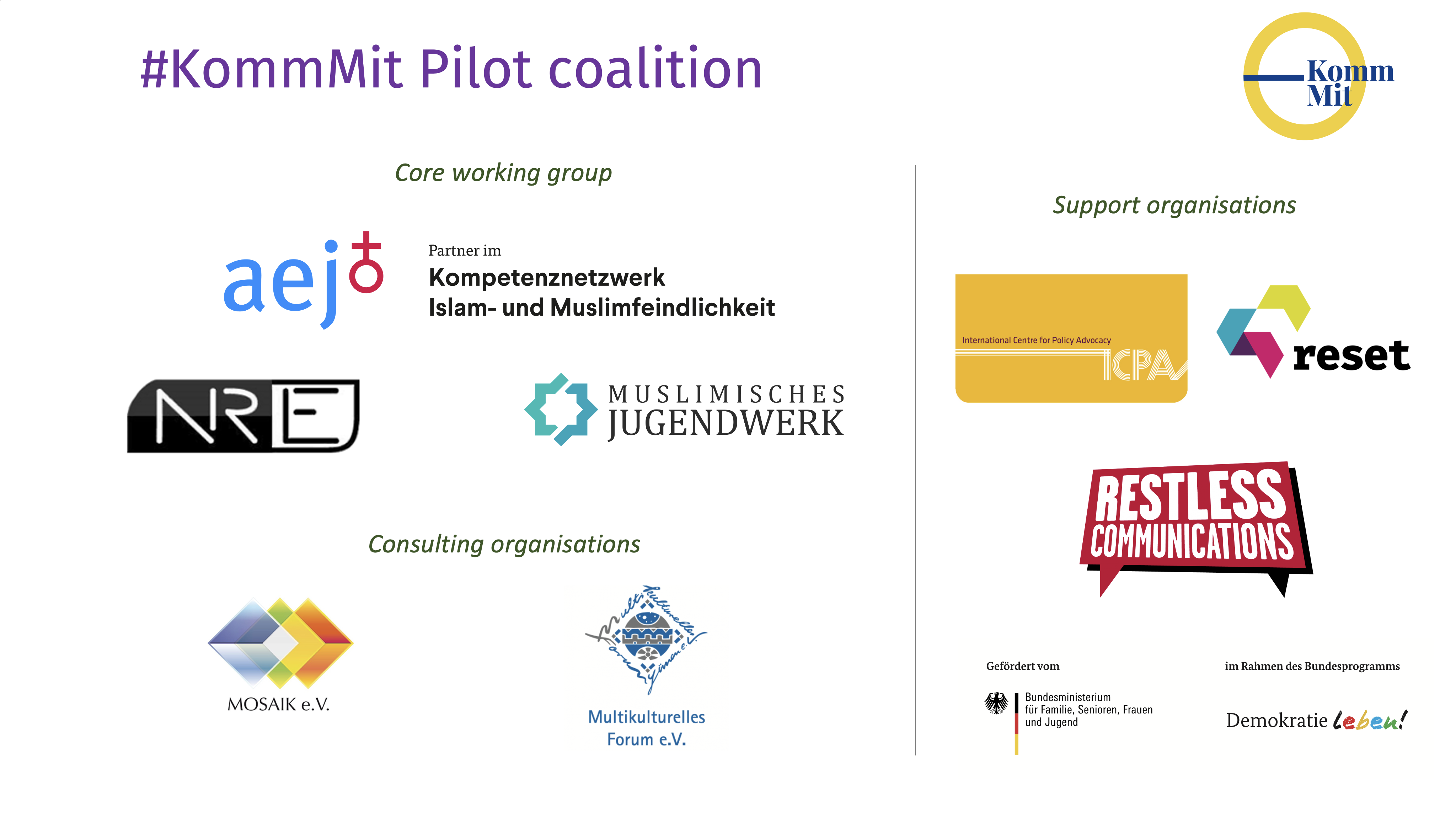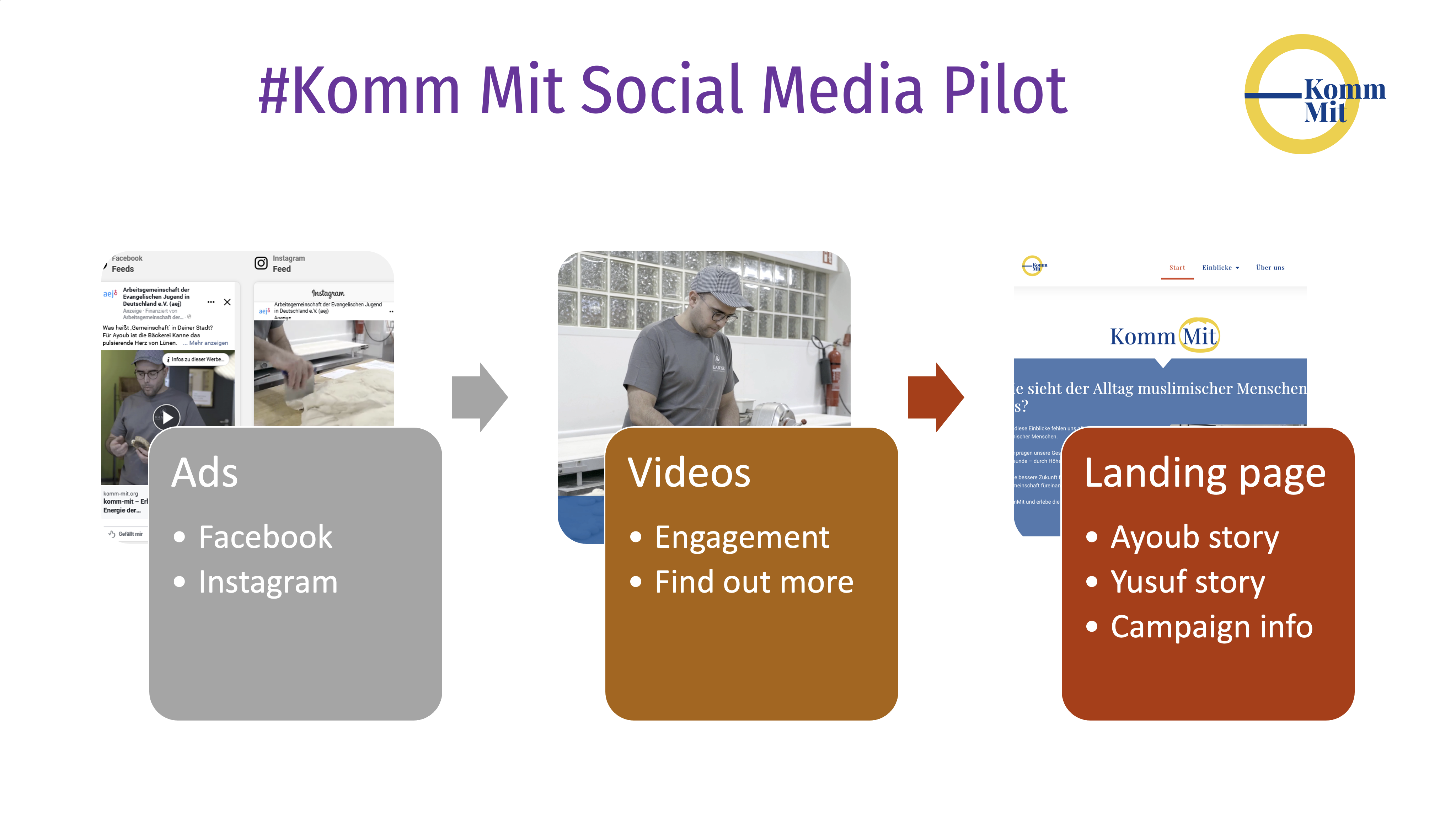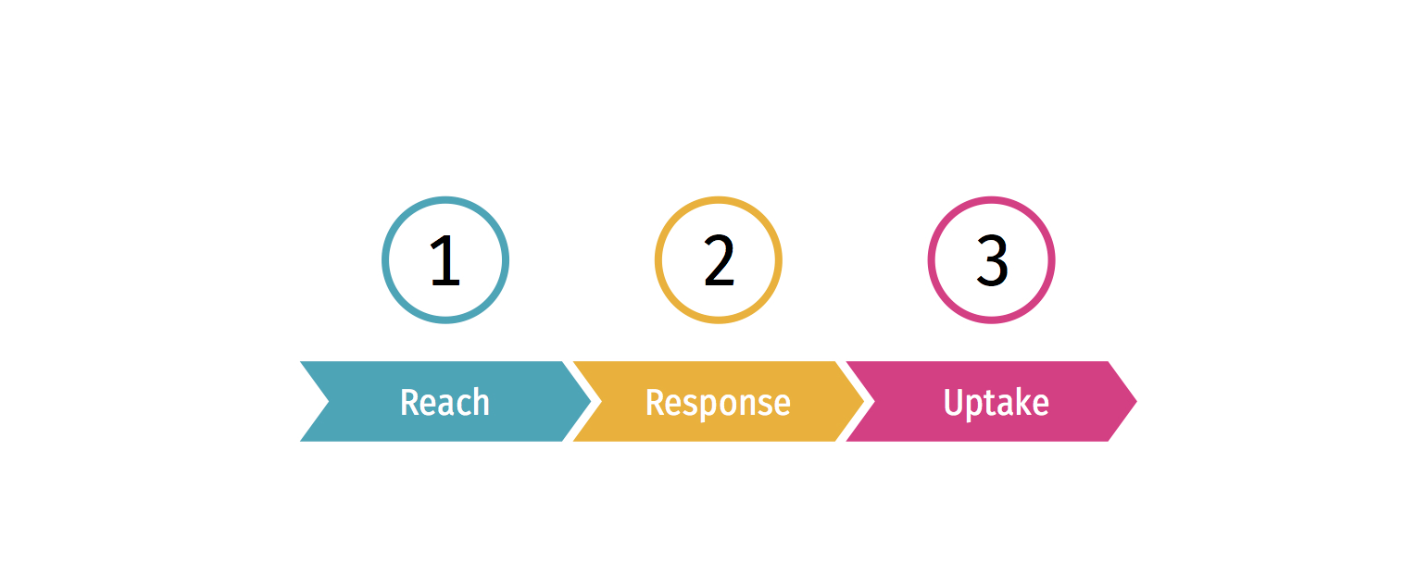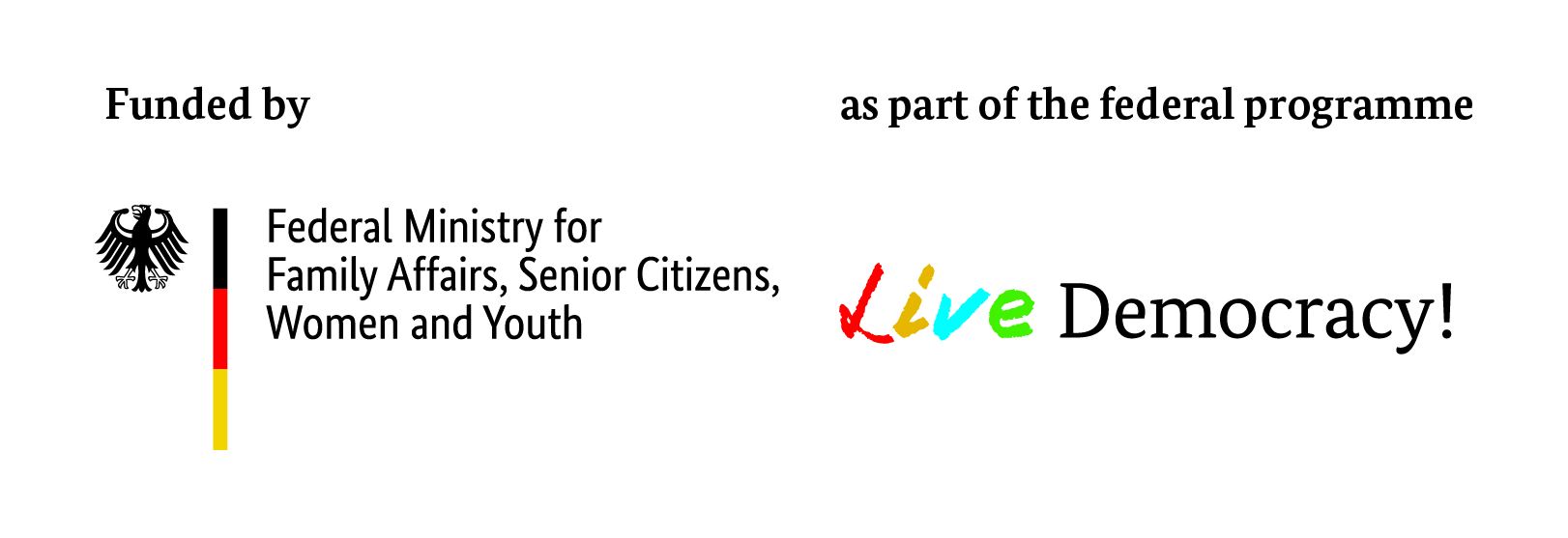#KommMit pilot narrative change project: A value-based storytelling approach shifts attitudes towards Muslims in Germany
This article shares the background, evaluation framework, key results and takeaways from the #KommMit pilot project. By illustrating successful narrative change in practice, we hope to inspire others to build on this success. To support the scaling up work, a #KommMit toolbox resource (coming in 2024) will flesh out the detail of the empirically grounded and tested strategy that works to positively shift attitudes of a key sector of the German middle on Muslims and integration. The toolbox will also share guidelines for adopting or adapting this strategy by practitioners promoting social cohesion, diversity and inclusion.
The #KommMit pilot project was developed by five members of the German nationwide CLAIM alliance1 with ICPA’s support within the RESET project based on ICPA’s value driven, reframing/narrative change approach (which is explained in detail the Reframing Migration Narratives Toolkit). Restless Communications supported with social media campaigning work run by a coalition of three CLAIM members2 in April-May 2023. The aim of the #KommMit pilot was to:
- demonstrate, through the testing and dissemination of value-driven, social cohesion stories of everyday lives of Muslims in Germany on a small scale, that activists can address and positively change attitudes of the target middle group - the "Established" - towards Muslims and people read as Muslim.

The #KommMit pilot is the culmination of an extensive capacity building and narrative development process - The New Narratives Lab – in which the ICPA team supported 22 participants from 15 CLAIM Allianz members and the staff of the head office in Berlin to develop and test their own empirically tested narrative change strategy targeting the movable middle, and to support the longer-term strategic communications goals of the network. After the strategy development phase, in 2022-2023, the Lab supported a core working group of five CLAIM members to develop and test the #KommMit narrative change strategy to constructively engage one specific segment of the movable middle.
Key features of the #KommMit pilot:
-
Target group and value appeals
CLAIM members chose to target “The Established”3 segment of the German movable middle with the following set of unifying value appeals that are shared between the CLAIM members in the Lab and the target middle segment selected:
- Interdependence and solidarity;
- Responsibility/Contribution/Participation;
- Stability/Security;
- Intergenerational futures.
These value appeals were initially tested in focus groups and verified in a national poll with middle groups (sample size of 1000) and they showed good resonance with the target segment. The protagonists included were all tradespeople and their role as trusted, valued, down to earth, backbone community members received a positive response from middle audiences in tests.
-
Three tradespeople as protagonists
The #KommMit pilot tested stories and social media content for three trades people protagonists: Ayoub, Yusuf and ‘Murat’. The protagonists agreed to work with the pilot at different levels with Ayoub happy for us to make videos and share his story on social media, and Yusuf consenting to share his story on the campaign website and test in a national poll, built on his existing social media profile. ‘Murat’ was a protagonist we interviewed, but decided that he didn’t want his story shared publicly, fearing some kind of backlash in the small community where he lives. So, we didn’t include him in the public side of the campaign, but were able to test his authentic stories under the fictional protagonist name ‘Murat’4 .
-
Social media pilot logic
The social media pilot was the main component of the #KommMit project run as a series of paid ads on Facebook and Instagram5 between April 27 - May 31, 2023. The logic of the pilot, as outlined in the diagram below, was to reach the target audience with ads that hosted 5 videos about the protagonist, Ayoub, measure how they responded to the messages and material, and then see how many people were motivated to visit the campaign website to find out more about Ayoub, the other protagonist (Yusuf) and the overall project.

-
Reaching the middle segment through paid ads
Using paid ads was the only way to effectively reach the target audience of “The Established” middle group en masse, as they are not natural supporters or followers of the campaigning organisations on their social media platforms. We sought expert advice in building an effective audience profile to use in Facebook Ad manager to ensure reach of the specific middle group. In addition, based on a demographic analysis, we identified that there are high concentrations of “Established” populations in the two states of Nordrhein Westfalen and Badem Wuttemburg. So, these target regions were chosen to increase the potential for engagement and the efficiency of the pilot.

The pilot sought to test whether value-based messaging and storytelling could shift attitudes, reduce anxiety and open constructive conversation around the issue of Muslims in Germany. Hence, the approach to evaluation is focused directly on understanding if the campaign materials and messages achieve this kind of response. As response-level testing was the focus of the pilot, the team did not invest in building partnerships with supporters, influencers and media to develop earned content or build their public support. Given this scope, the evaluation focused on reach and response targets (and not on uptake) in ICPA’s evaluation framework for narrative change campaigns (See figure 1 above).
Moving beyond the terminology, these were the specific questions for each level of the evaluation and an overview of the results achieved:
| Target Level | Key Question | Results | Targets/Benchmarks |
|---|---|---|---|
|
a. Reach
|
1. Did the content appear in the social media feeds of a significant number of the target segment? | The material reached 9% or 200,000 members of the Established in the target regions at half the normal market price | This is nearly twice as many as expected, as our ‘good level’ target for narrative change campaigns is to reach 5% of a target segment. The cost was €1.44 to reach 1000 people vs average of €2.806 . |
|
b. Response
|
2. Were the ads, copy and video material engaging for the audience? | The campaign content worked very well to engage the target audience, delivering three times the expected engagement rate. The videos also held the attention of a significant number of viewers. | The material delivered 93,368 engagements vs max expected of 34,834 predicted by Facebook Manager. The video play rate was 0,03 cent/€ for a 15+ play vs target of between 5 to 10 Cents7 . |
| 3. What kind of sentiment did the ads, copy and videos produce in response? | The materials produced between 80 to 90% of positive responses on Facebook and in the Randomised Control Trial test. Additionally, the material did not get any strongly negative or hate speech responses. | 80 to 90% positive or neutral is a target from previous ICPA supported middle campaigns. | |
| 4. Was the material interesting enough to want to find out more on the campaign webpage? | Over three times the number of people went to the campaign website to find out more compared to campaign averages | The Click Through Rate of 3,5% vs market average of 1,2% and interestingly, these were twice as many women versus men. | |
| 5. Does the material positively shift the attitudes of middle segments on migration and Muslims? | The material significantly moved attitudes on migration and Muslims in the positive direction by + 6 points. | The result of +6% target compares to an average +2% benchmark on Randomised Controlled Trials8 . |
From the table above, the most significant results were:
1. Value-based messaging with authentic storytelling positively shifted the attitudes of the target middle group on Muslims and integration.

As can be seen from the diagram above, the main aim of the pilot was proven with value-driven storytelling proving to be an approach that works to positively and significantly shift the attitudes of “The Established” segment. It is significant that the attitude shift was three times the average of what is normally achieved in such tests! This result was generated from three separate tests called “Randomised Controlled Trials”9 conducted with 4400 people, i.e. tests on #KommMit videos and storyboards for the three protagonists in which a test group sees the campaign material and answers attitude questions. In parallel, a control group sees some neutral video on a random topic and answers the same questions. The results from the two groups are compared to generate the attitude shift score – in this case 6%. This specific result should provide great encouragement for those wishing to engage middle groups and tip the balance in political debates back towards a focus on the values of diversity and inclusion. A 6% shift may not sound like a lot, but the significance of even the benchmark of 2% can be illustrated as the difference between a progressive candidate in a local community getting elected or a far-right candidate not getting elected.
2. #KommMit reached twice as many of the Established as expected (approximately 200,000), and at an affordable cost.
In previous middle-oriented narrative change campaigns we have supported in Germany, the target segment reach was 4%-5% and therefore, this was set as the target and benchmark in the #KommMit pilot.

The challenge with reach is to develop content and copy that works within the limitations of the social media algorithm and also gets good engagement from the target audience. Investing in building a targeted audience profile was key, as was producing content that fit the social media mindset, i.e. short punchy videos that hold attention. In previous campaigns we supported, when the material was not as social media friendly, partners even had a problem spending the planned budget on various social media platforms.
Further, there is always a cost aspect to reach: #KommMit reached the target audience at half market rates, i.e. cost per thousand people reached was €1.44 vs a German market average of €2.8010 . In total, an ad budget of €2,500 was spent to reach this number11 . These reach results show that it is possible and affordable to put more positive messaging about Muslims in the social media feeds of those groups who don’t often see such material, and who are indeed movable.
3. The campaign material triggered a high level of engagement, with over 80% positive responses and no outbursts of strong attacks or hate speech from the target middle group.
The basic logic of a value-based approach is to effectively engage the target group to reduce their anxiety towards the societal issue in question with warmer positive messaging, while still challenging underlying beliefs in an emotionally smart way. This sets the ground for opening a constructive conversation. Getting this balance of resonance and dissonance right in the messaging and content is a challenge, and the #KommMit pilot succeeded in getting a very high level of engagement as well as getting the emotional balance right. This is evident from the fact that the vast majority of comments on both social media and in the Randomised Control Test had a positive focus or asked neutral questions and there were no hate speech-based responses from the target middle segment.
This response result is important as its shows that it is possible to have constructive, social cohesion-based conversations with middle groups without the aggression and hate speech too often experienced by activists in response to their campaigns. Further, we also hope that these more constructive responses will encourage more protagonists to share their everyday stories in similar campaigns.
4. The values of ‘participation through professional lives’ and ‘care for intergenerational futures’ show particular promise in shifting attitudes.
The content that continually got the best results with “The Established” target audience were stories of how the tradespeople protagonists enthusiastically engage their professions towards shared community goals and challenges such as renovation work and efforts to preserve traditions and key services such as local bakeries. In addition, stories that focus on protagonist’s own learning and apprenticeship, as well as and teaching the next generations, proved to be some of the best performing content. See the example below:
This response result shows promise for other campaigners who wish to adopt the #KommMit strategy to develop their own stories and add to the existing bank of stories. In addition, for those wishing to adapt the strategy for their own purposes, these proven value appeals and storytelling approaches provide a solid foundation to build on.
5. The #KommMit messaging and storytelling content is a demographic unifier.
Positive messaging on divisive societal issues like migration often divides support, with tests showing that target groups from lower income and education brackets are less supportive. However, the results show that this was not the case with #KommMit. In fact, the content produced similar positive shifts across all income brackets and education levels. Therefore, this type of messaging shows promise as a basis to build broad-scale public support using a campaigning approach, and this result has extra significance in this time of inflation and economic downturn.

The results of the #KommMit pilot far exceeded our targets for such NGO campaigns targeting the middle in Germany. These results should be encouraging for others wishing to engage middle groups and drive a social cohesion agenda. In fact, it is the intention of the CLAIM members who developed #KommMit that others adopt or adapt the strategy and take it to a bigger scale.
The key takeaways to support scaling up this narrative change work are:
1. Value-based messaging works to open the door to influence with the middle audience of the “Established”.
Even in the more challenging times we are living in, with the rise of more polarisation in debates on migration and Islam12 , a value-based approach works to open space for a constructive social cohesion framed debate with a key segment of the population, “The Established”. As they are an older group comprising many parents and grandparents who are very connected and engaged in their communities, their opinions on these issues can have an outsized influence and be very important in local decision-making and agenda setting. Having them on your side could be the balance between gaining community support on your issue or not.
2. #KommMit shows that you can effectively reach and engage “The Established” at low cost, making “flooding the zone” with positive stories a feasible target.
Through the focus groups we conducted in the Lab process, it became clear that even though there is some openness among middle groups, some strong negative associations still exist that need to be challenged, i.e. that Muslim equals foreigner, and that positive stories of the lives of Muslims in Germany are exceptions rather than commonplace. Embedding the #KommMit strategy in a long-term strategic communications perspective, the goal in scaling up this pilot is to build the continual presence of stories like those in the pilot to the point that these assumptions become questioned by those in the middle and eventually undermined. This would take a considerable longer-term investment, but the pilot proves that it can be done effectively and at a relatively low cost. Therefore, a so-called “flooding the zone” strategy is a realistic option to contribute to making important change.
3. The rigour of investing in an empirically-driven, test and learn approach is worthwhile and builds confidence.
Targeting middle audiences who are often unfamiliar to campaigners means you can rather easily make assumptions in your messaging that don’t actually resonate with such audiences and can even risk backfiring. So, it is key to take a rigorous, empirically-driven approach to find what works for you and also changes attitudes in the positive. In the New Narratives Lab, we started from an understanding of public attitudes from the More in Common 2019 study. Then through the various stages of development we navigated the following testing and validation process:

This gave the #KommMit campaigning coalition the evidence needed to have confidence we were going in a good direction. Of course, as this was a pilot project with the key question of whether such an approach could work, we did invest quite a lot at each stage of the testing. We are not assuming that most campaigners will do exactly the same, but a commitment to understanding what is working and what is not is very important. We concur with our colleagues who say that “any testing is better than no testing”13 . To understand more about testing options for narrative change, see our new resource on testing methods.
4. Proven short-term attitude change is a foundation for longer term sustainable change
The question we are always asked about campaigning is how long will a positive attitude shift hold, especially with a group that are even named as ‘movable’. And the answer we can expect realistically is no longer than through the target media cycle or debate. But ultimately, as mentioned above, the strategic communications target of presence should be the aim, where continual sharing of such messages and stories become “surround sound” for such target audiences in this debate, and slowly but surely become the norm14 . This will take significant investment in infrastructure and ultimately, a movement of allies willing to strategically engage and convince these middle segments of the population.
The #KommMit pilot delivered the intended proof the concept and provides a tried and tested strategy and content that has achieved significant attitude shift among an important segment of the public. It offers to those who wish to take on the approach a chance to adopt, adapt and expand the strategy and if delivered at scale with the intent to build the broad presence of such messaging, the chance to tip the scale in the direction of diversity and inclusion.
Finally, the RESET project has also built the capacity of a team of narrative change specialists within CLAIM network (certified by ICPA) who can lead or support on this important work. And a much more in-depth and practical toolbox on each element of the approach will be delivered soon.
The blog was developed in the framework of ICPA’s RESET project. Support for researching and developing the case study was provided by:

This publication does not express the opinions of BMFSFJ or BAFzA. The authors are solely responsible for the content of the publication.
- 1Arbeitsgemeinschaft der Evangelischen Jugend in Deutschland e. V. (aej) & Netzwerk gegen Islamfeindlichkeit und Rassismus Leipzig e.V. & Muslimische Jugendwerk & Multikulturelle Forum e.V. & Mosaik e.V.
- 2Arbeitsgemeinschaft der Evangelischen Jugend in Deutschland e. V. (aej) & Netzwerk gegen Islamfeindlichkeit und Rassismus Leipzig e.V. & Muslimische Jugendwerk
- 3See a short description of the Established and other segments in this debate.
- 4To protect his identity in the testing process, we changed his name, didn’t reveal his location or use any pictures of him or his workplace. However, the stories tested were based directly on his experiences and challenges.
- 5The platforms used most by The Established as identified by More in Common (2022)
- 6This metric is called the Cost per Thousand (CPM) on Facebook Ad Manager. The market average of €2.80 was taken from this source in April 2023 - https://www.zweidigital.de/facebook-cpm-cpc-ctr/
- 7This metric is called the ThruPlay rate on Facebook Ad Manager. The ThruPLay rate of 5 to 10 cents was taken from this source - https://customers.ai/blog/how-to-do-facebook-remarketing#:~:text=If%20your%20posts%20are%20B2B,every%2010%20posts%20you%20try
- 8The benchmark comes from Swayable who have run thousands of similar tests.
- 9See the resource for more detail on this and other testing methods for narrative change - http://www.narrativechange.org/message-testing-methods
- 10The market average of €2.80 was taken from this source in April 2023 - https://www.zweidigital.de/facebook-cpm-cpc-ctr/
- 11Obviously making the videos and website design & hosting etc cost extra outside of this.
- 12See More in Common (2023) & Friedrich Ebert Stiftung (2023)
- 13https://publicinterest.org.uk/project/framing-equality/
- 14http://www.narrativechange.org/toolkit/what-strategic-communications

